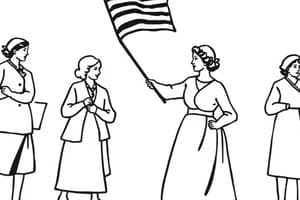Podcast
Questions and Answers
What did the 19th Amendment specifically address in terms of voting rights?
What did the 19th Amendment specifically address in terms of voting rights?
Sex
When was the 19th Amendment proposed by Congress?
When was the 19th Amendment proposed by Congress?
June 4, 1919
Which state became the 36th and final state to approve the 19th Amendment?
Which state became the 36th and final state to approve the 19th Amendment?
Tennessee
What impact did the 19th Amendment have on women in politics?
What impact did the 19th Amendment have on women in politics?
What groups continued to face challenges in accessing the ballot box even after the 19th Amendment was passed?
What groups continued to face challenges in accessing the ballot box even after the 19th Amendment was passed?
What is the significance of the 19th Amendment to the U.S. Constitution?
What is the significance of the 19th Amendment to the U.S. Constitution?
When was the 19th Amendment ratified?
When was the 19th Amendment ratified?
What were some initial focuses of the women's suffrage movement in the 19th century?
What were some initial focuses of the women's suffrage movement in the 19th century?
What events contributed to the growing prominence of the issue of voting rights for women in the late 19th century?
What events contributed to the growing prominence of the issue of voting rights for women in the late 19th century?
What was the initial focus of the 19th Amendment when it was drafted?
What was the initial focus of the 19th Amendment when it was drafted?
Study Notes
The 19th Amendment: Granting Women's Right to Vote
The 19th Amendment to the U.S. Constitution, ratified on August 18, 1920, is a significant milestone in the history of American democracy. Often referred to as the suffrage amendment, it granted women the right to vote, marking the first time in U.S. history that voting rights were extended to all adult citizens regardless of sex.
Background
The fight for women's suffrage began in the 19th century, driven by the Progressive Era's reform movement and the growing awareness of women's role in society. Initially, the movement focused on equal rights for women in property, education, and employment. However, as women's contributions to the Civil War effort and their increased participation in the workforce became evident, the issue of voting rights quickly gained prominence.
Throughout the late 19th century, suffragists organized, petitioned, marched, and lobbied for the right to vote. The movement was met with resistance, and many states passed laws hindering women's access to the ballot. By the early 20th century, however, momentum had grown, and a coordinated, nationwide effort to ratify the 19th Amendment gained traction.
The Drafting of the 19th Amendment
The 19th Amendment was drafted to address the lack of women's suffrage at both the state and federal levels. The proposal began with the 15th Amendment, which granted African American men the right to vote in 1870. However, as the amendment made no mention of women, suffragists continued their fight for equal voting rights.
The text of the 19th Amendment is concise: "The right of citizens of the United States to vote shall not be denied or abridged by the United States or by any State on account of sex." This language was deliberately inclusive, ensuring that all qualified citizens, regardless of sex, were granted the right to vote.
The Ratification Process
The 19th Amendment was proposed by Congress on June 4, 1919, and submitted to the states for ratification on August 18, 1920. The amendment required a two-thirds majority vote from three-fourths of the states to pass. Ratification spread across the country, with Tennessee becoming the 36th and final state to approve the amendment on August 18, 1920.
The Impact of the 19th Amendment
The 19th Amendment's passage had a profound impact on American society. For the first time, women were able to vote in federal and state elections and participate in the democratic process. The 19th Amendment also opened doors for women in politics, as women began to run for office and hold elected positions at all levels of government.
While the passage of the 19th Amendment marked a significant milestone in women's rights, it was not the end of the fight for equality. Women of color and other marginalized groups continued to face challenges in accessing the ballot box, and the struggle for equal rights continued well into the 20th century.
Today, the 19th Amendment remains an essential part of the U.S. Constitution, and women continue to exercise their right to vote and participate in the democratic process. While progress has been made, challenges persist, and it is essential that we honor the legacy of the suffragists and continue to fight for the rights of all citizens, regardless of sex, race, or creed.
Studying That Suits You
Use AI to generate personalized quizzes and flashcards to suit your learning preferences.
Description
Explore the history, significance, drafting, and impact of the 19th Amendment, a pivotal moment in American democracy that granted women the right to vote. Learn about the suffrage movement, the ratification process, and the ongoing fight for equality in voting rights.




